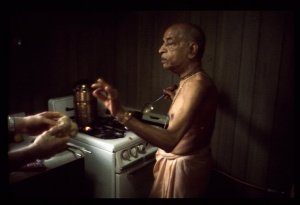SB 3.26.15: Difference between revisions
m (1 revision(s)) |
No edit summary |
||
| Line 1: | Line 1: | ||
{{info | {{info | ||
|speaker=Lord Kapiladeva the Supreme Personaliy of Godhead | |speaker=Lord Kapiladeva the Supreme Personaliy of Godhead | ||
|listener=Devahūti, mother of Lord Kapiladeva | |listener=Devahūti, mother of Lord Kapiladeva | ||
}} | }} | ||
[[Category:Srimad-Bhagavatam - Canto 03 Chapter 26]] | |||
[[Category:Bhagavatam Verses Spoken by Lord Kapila - Vanisource|032615]] | |||
<div style="float:left">'''[[Srimad-Bhagavatam]] - [[SB 3|Third Canto]] - [[SB 3.26: Fundamental Principles of Material Nature|Chapter 26: Fundamental Principles of Material Nature]]'''</div> | |||
<div style="float:right">[[File:Go-previous.png|link=SB 3.26.14]] '''[[SB 3.26.14]] - [[SB 3.26.16]]''' [[File:Go-next.png|link=SB 3.26.16]]</div> | |||
{{RandomImage}} | |||
==== TEXT 15 ==== | ==== TEXT 15 ==== | ||
<div | <div class="verse"> | ||
etāvān eva saṅkhyāto | :etāvān eva saṅkhyāto | ||
brahmaṇaḥ sa-guṇasya ha | :brahmaṇaḥ sa-guṇasya ha | ||
sanniveśo mayā prokto | :sanniveśo mayā prokto | ||
yaḥ kālaḥ pañca-viṁśakaḥ | :yaḥ kālaḥ pañca-viṁśakaḥ | ||
</div> | </div> | ||
| Line 16: | Line 22: | ||
==== SYNONYMS ==== | ==== SYNONYMS ==== | ||
<div | <div class="synonyms"> | ||
''etāvān''—so much; ''eva''—just; ''saṅkhyātaḥ''—enumerated; ''brahmaṇaḥ''—of Brahman; ''sa-guṇasya''—with material qualities; ''ha''—indeed; ''sanniveśaḥ''—arrangement; ''mayā''—by Me; ''proktaḥ''—spoken; ''yaḥ''—which; ''kālaḥ''—time; ''pañca-viṁśakaḥ''—the twenty-fifth. | |||
</div> | </div> | ||
| Line 23: | Line 29: | ||
==== TRANSLATION ==== | ==== TRANSLATION ==== | ||
<div | <div class="translation"> | ||
All these are considered the qualified Brahman. The mixing element, which is known as time, is counted as the twenty-fifth element. | All these are considered the qualified Brahman. The mixing element, which is known as time, is counted as the twenty-fifth element. | ||
</div> | </div> | ||
| Line 30: | Line 36: | ||
==== PURPORT ==== | ==== PURPORT ==== | ||
<div | <div class="purport"> | ||
According to the Vedic version there is no existence beyond Brahman. Sarvaṁ khalv idaṁ brahma (Chāndogya Upaniṣad 3.14.1). It is stated also in the Viṣṇu Purāṇa that whatever we see is parasya brahmaṇaḥ śaktiḥ; everything is an expansion of the energy of the Supreme Absolute Truth, Brahman. When Brahman is mixed with the three qualities goodness, passion and ignorance, there results the material expansion, which is sometimes called saguṇa Brahman and which consists of these twenty-five elements. In the nirguṇa Brahman, where there is no material contamination, or in the spiritual world, the three modes—goodness, passion and ignorance—are not present. Where nirguṇa Brahman is found, simple unalloyed goodness prevails. Saguṇa Brahman is described by the Sāṅkhya system of philosophy as consisting of twenty-five elements, including the time factor (past, present and future). | According to the Vedic version there is no existence beyond Brahman. ''Sarvaṁ khalv idaṁ brahma'' (''Chāndogya Upaniṣad'' 3.14.1). It is stated also in the ''Viṣṇu Purāṇa'' that whatever we see is ''parasya brahmaṇaḥ śaktiḥ''; everything is an expansion of the energy of the Supreme Absolute Truth, Brahman. When Brahman is mixed with the three qualities goodness, passion and ignorance, there results the material expansion, which is sometimes called ''saguṇa'' Brahman and which consists of these twenty-five elements. In the ''nirguṇa'' Brahman, where there is no material contamination, or in the spiritual world, the three modes—goodness, passion and ignorance—are not present. Where ''nirguṇa'' Brahman is found, simple unalloyed goodness prevails. ''Saguṇa'' Brahman is described by the Sāṅkhya system of philosophy as consisting of twenty-five elements, including the time factor (past, present and future). | ||
</div> | </div> | ||
__NOTOC__ | |||
<div style="float:right; clear:both;">[[File:Go-previous.png|link=SB 3.26.14]] '''[[SB 3.26.14]] - [[SB 3.26.16]]''' [[File:Go-next.png|link=SB 3.26.16]]</div> | |||
__NOTOC__ | |||
__NOEDITSECTION__ | |||
Revision as of 09:28, 8 May 2021

A.C. Bhaktivedanta Swami Prabhupada
TEXT 15
- etāvān eva saṅkhyāto
- brahmaṇaḥ sa-guṇasya ha
- sanniveśo mayā prokto
- yaḥ kālaḥ pañca-viṁśakaḥ
SYNONYMS
etāvān—so much; eva—just; saṅkhyātaḥ—enumerated; brahmaṇaḥ—of Brahman; sa-guṇasya—with material qualities; ha—indeed; sanniveśaḥ—arrangement; mayā—by Me; proktaḥ—spoken; yaḥ—which; kālaḥ—time; pañca-viṁśakaḥ—the twenty-fifth.
TRANSLATION
All these are considered the qualified Brahman. The mixing element, which is known as time, is counted as the twenty-fifth element.
PURPORT
According to the Vedic version there is no existence beyond Brahman. Sarvaṁ khalv idaṁ brahma (Chāndogya Upaniṣad 3.14.1). It is stated also in the Viṣṇu Purāṇa that whatever we see is parasya brahmaṇaḥ śaktiḥ; everything is an expansion of the energy of the Supreme Absolute Truth, Brahman. When Brahman is mixed with the three qualities goodness, passion and ignorance, there results the material expansion, which is sometimes called saguṇa Brahman and which consists of these twenty-five elements. In the nirguṇa Brahman, where there is no material contamination, or in the spiritual world, the three modes—goodness, passion and ignorance—are not present. Where nirguṇa Brahman is found, simple unalloyed goodness prevails. Saguṇa Brahman is described by the Sāṅkhya system of philosophy as consisting of twenty-five elements, including the time factor (past, present and future).